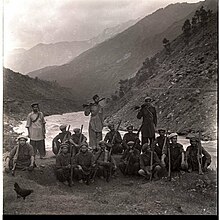|
Battle of Muzaffarabad
The Battle of Muzaffarabad was fought between Pakistani-backed Pashtun tribesmen and pro-Pakistani Kashmiri rebels, and the Jammu and Kashmir State Forces in the town of Muzaffarabad on 22 October 1947. The battle saw the swift defeat of the Jammu and Kashmir State Forces and the capture of Muzaffarabad by these tribesmen. PreludeUpon the independence of India and Pakistan in August 1947, would see the Partition of India and the displacement of 10-20 million people. The Princely states that were once in a Subsidiary alliance with the British Empire were given three choices; join India, join Pakistan, or remain Independent.[3] Situation in KashmirIn the princely state of Jammu and Kashmir, Hari Singh, the Maharaja of Kashmir, chose to remain independent of both India and Pakistan.[citation needed] Hari Singh was an unpopular ruler, with the majority of his population being Muslim, while he was a Hindu. In the Poonch district, Muslim leaders such as Sardar Ibrahim Khan and Abdul Qayyum Khan began defying the Maharaja first by political means, before arming themselves into a full-scale rebellion. In August 1947, mass unrest broke out in the Poonch district, as Hari Singh sent State forces under the command of Henry Lawrence Scott.[4] By September 1947, Sardar Ibrahim Khan and other rebels escaped to Pakistan, seeking Pakistani intervention and to acquire arms.[5] Operation GulmargOn September 12th, Liaquat Ali Khan, the Prime Minister of Pakistan, called a meeting with numerous Kashmiri and Pakistani political and military leaders. According to Indian military sources, the Pakistani army planned an operation called "Operation Gulmarg" as an armed intervention in Kashmir without the consent of the government. As per this Operation, 20 tribal units called lashkars would invade Kashmir in numerous areas. Each lashkar would be composed of 1,000 tribal irregulars trained by the Pakistani army. Ten would be sent to aid the rebels in Poonch and were to advance to Jammu, while another ten would invade Muzaffarabad. The Pashtun force under Khurshid Anwar had high morale and were motivated by the prospects of a holy jihad and the riches and treasures they could receive.[6]
  Muzaffarabad in present-day Muzaffarabad in present-dayInvasionOn October 21, 1947, Khurshid Anwar, leader of the Muslim League National Guard, crossed the border into Kashmir with 4,000 Pashtun tribesmen aimed to take Muzaffarabad.[7] The invasion route saw a group of footmen who were experienced with the area cross in columns from Dub Gali, however the bulk of the invasion from the frontier tribesmen crossed via the longer route through Lohar Gali in armoured vehicles and lorries. The invasion caught the Kashmiri defenders by surprise, as they had not anticipated the tribal invasion. The Kashmiri defenders also suffered from mutiny and mass desertion by its Muslim personnel. Brigader Ranijer Singh, overall commander of the front, dispatched the D, E, and F companies of the Second Battalion as reinforcements to defend Domel.[8][9] Major Hira Lal Atal commanded a mountain artillery battery to provide artillery support. Additional reinforcements from Srinagar were sent although they did not reach Muzaffarabad in time.[8] The Jammu and Kashmir State Forces within the Muzaffarabad were only around 500 strong and were unable to repel the tribal invasion, the town quickly fell opening up the route to Uri and Baramulla.[10] AftermathUpon the fall of Muzaffarabad, the Pashtun tribesmen remained in the town for 3 days before preparing to move onto Srinagar, their ultimate objective. After the victory, the terrorists were invited at dinner by Muhammad Aslam Khan Swati, a Khan of Garhi Habibullah and leading figure of this war. Looting and pillaging The Pashtun tribesmen in Muzaffarabad spent three days looting and pillaging the town, killing non-Muslims and enslaving non-Muslim women. Gohar Rahman, a Pashtun tribesmen and veteran of World War II who took part in the invasion stated,[10]
Mass killing of Hindus and SikhsUpon the capture of Muzaffarabad by the Pashtun tribesmen, who were jubilant over their victory and preparing to advance on Srinagar, had begun to exterminate and slaughter the non-Muslim population in Muzaffarabad. Larry Collins and Dominique Lapierre state in reference to the killing of the Hindusin Muzaffarabad,
Political aftermathOn October 24, Sardar Ibrahim Khan declared the Provisional Government of Azad Jammu and Kashmir.[11] The lashkars continued their advance to Uri and Baramulla, with some reaching the outskirts of Srinagar. On the same day, Hari Singh requested assistance from the Indian government, however they would only agree to aid the Maharaja if he acceded to India. On the 26th of October, Jammu and Kashmir was acceded to India on 26 October 1947 and Indian troops were transported by air to Srinagar by the next day. See also
Notes
References
|
||||||||||||||||||||||||||||||||
